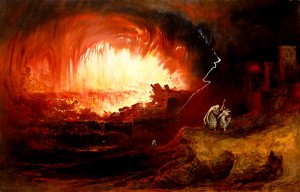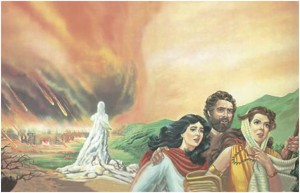Vayero 2015 – Looking Backward: Bad For Your Health
by devadmin | October 29, 2015 3:38 pm
Looking Backward: Bad For Your Health
Shoin, long before the Five Towns were established as early as 1931, there were seemingly five other neighboring towns, all mentioned in the heylige Toirah and they can be found in this week’s parsha and also last week’s. Though this week’s parsha of Vayero, which we will have the great pleasure of reading this coming Shabbis is most famous for ‘Akaydas Yitzchok’ (Binding of Isaac), it is also loaded with other storylines and among them the destruction of the Sedoim and Gomorrah. Ober, did you know that these two towns were but 2 of 5 initially marked for total destruction? There were others? Which ones and why are they not mentioned along with Sedoim and Gomorrah? Are they?
Wait just a moment. Did we just mention that other cities besides Sedoim and Gomorrah were destroyed? We did. Efsher you recall that the RBSO deemed Loit, Avrohom’s nephew, worthy of being saved from the ashes of Sedoim and Gomorro. And avada you will recall learning as we all did altz kleyna kinder (as kids) that Sedoim was one hell of a place to live. Its inhabitants were mamish shlecht personified. You can avada find all the details in the heylige Toirah, the heylige Gemoras and medroshim that expound on the behavior of the Sodomites so that the average reader can chap just why the RBSO had enough and decided it was time for Sodom to be no more. It’s taka emes and bavust (well known) what took place and why the RBSO destroyed Sodom and Gomorra, ober which other towns were engulfed in flames and sulfur?
Nu, lommer lernin. Avada you all recall that the malochim (angels) came to Loit and warned him to immediately leave the city, he and his family. Ober if you take a look at perek chof, pisukim 18-21 (Chapter 20, 18-21), we will find a very interesting exchange between Loit and the malochim. Loit is in negotiations with the malochim. They had just told Loit to skedaddle out of Sedoim and head over to the mountains, ober Loit counters and says azoy: “….but I cannot escape to the mountain lest the evil attach itself to me and I will die.” Loit goes on to ask the malochim for permission to instead escape to one small city. And guess what? The malochim accommodate his request and agree to let Loit instead flee to one of the smaller cities, a place Loit later named Tzoiar (Zoar). Ober where was Tzoiar and what were the surrounding towns?
Shoin, after a careful review of the storyline as presented by Rashi and a few other sources, it turns out that there were taka initially five towns or cities that were marked for destruction. And where can we find these delineated? In the heylige Toirah, where else? Shoin, we need to turn back to Parshas Lech Lecho, where we read just last week of some war we never understood between the four kings and the five kings, a war which ultimately resulted in Loit being captured, taken captive. That same war and Loit’s captivity resulted in Avrohom, though busy doing chesed all day, being forced into action – war action – to save his nephew Loit. In any event, the heylige Toirah will tell us that the five neighboring cities were Sedoim, Gomorrah, Admah, Zeboim and Bella. And it was Bella, the smallest and least populous that Loit eventually escaped to with permission of the malochim and it was Bella that he renamed Tzoiar. Moreover, if you look back at the negotiation that uncle Avrohom had with the RBSO about His plans of destroying Sedoim and Gomorrah, you will find Avrohom asking the RBSO if He would still destroy the cities were He to find 50 righteous among them. Rashi will tell us that what Avrohom had in mind was a total of 50 among all the towns or 10 in each city. Luckily it so happens that the Five Towns of today, has at least 10 good guys and mistama a lot more in each town. Of course, not even 10 good guys could be found and ultimately Avrohom walked away from the negotiations. Ober why was one town saved while the others were marked and destroyed?
Nu, Rashi will tell us that Bella was the smallest of the towns and was populated later than the others. It was less populous and, as a result, it had fewer sinners. Seemingly, the RBSO therefore gave the malochim some leeway and allowed this place to be spared, and for Loit to settle there, at least temporarily. On the other hand, another Rashi (Bereishis 14:2) will teach us that Bella was bad mamish: “Bella was bad to the RBSO and bad to its inhabitants.” Why taka was Bella saved, ver veyst? Shoin, who said that one Rashi needs to necessarily correspond or match up with another?
 In previous postings, we reviewed different medroshim to see how they danced around the very sensitive issue of Loit having sex -not knowingly according to the heylige Toirah- with both of his daughters on consecutive nights. And dancing they did for how else can such behavior be explained? So happens that the medrish is an excellent source book for excuses of minuvildike behavior and one that chaps should always consult one. Hey, in a few weeks the medrish will exonerate Yehudah while blaming Tamar and will find ways of whitewashing Reuvain for the mounting he did with one of his stepmothers. Stay tuned. Many ideas are discussed and most of them come to the defense of the daughters; they paint Loit as the bad guy, the fellow who lusted and the girls innocent mamish. In case you forgot, Rashi will tell us, and who knew better, that they bed their father because they looked around Tzoiar and saw that no man was left alive. They felt it was their duty to repopulate the world and with no other man in sight, they shikkered up (plied him with wine) their unsuspecting father and on consecutive nights had their way with him. Both became immediately pregnant and gave birth. Shoin, we won’t be me-a-rech (expand) on this topic, ober, shtelt zich di sahylo (the question arises, as did Loit) azoy: How could these two cunning girls possibly believe that no man and no one was left alive in Tzoiar when we just learned that the malochim (angels) allowed Loit and the girls to escape to that smaller town and spared Tzoiar from destruction? Were we not just taught (in the paragraphs above) that the entire town was saved? We were! What’s taka pshat here? Gotcha!!
In previous postings, we reviewed different medroshim to see how they danced around the very sensitive issue of Loit having sex -not knowingly according to the heylige Toirah- with both of his daughters on consecutive nights. And dancing they did for how else can such behavior be explained? So happens that the medrish is an excellent source book for excuses of minuvildike behavior and one that chaps should always consult one. Hey, in a few weeks the medrish will exonerate Yehudah while blaming Tamar and will find ways of whitewashing Reuvain for the mounting he did with one of his stepmothers. Stay tuned. Many ideas are discussed and most of them come to the defense of the daughters; they paint Loit as the bad guy, the fellow who lusted and the girls innocent mamish. In case you forgot, Rashi will tell us, and who knew better, that they bed their father because they looked around Tzoiar and saw that no man was left alive. They felt it was their duty to repopulate the world and with no other man in sight, they shikkered up (plied him with wine) their unsuspecting father and on consecutive nights had their way with him. Both became immediately pregnant and gave birth. Shoin, we won’t be me-a-rech (expand) on this topic, ober, shtelt zich di sahylo (the question arises, as did Loit) azoy: How could these two cunning girls possibly believe that no man and no one was left alive in Tzoiar when we just learned that the malochim (angels) allowed Loit and the girls to escape to that smaller town and spared Tzoiar from destruction? Were we not just taught (in the paragraphs above) that the entire town was saved? We were! What’s taka pshat here? Gotcha!!
Nu, it’s taka an excellent question ober says the Toisfis Rid -whoever that was, azoy: Following the destruction of Sedoim and its surroundings, those who survived – those very people in the town of Tzoiar- went into hiding. Given the destruction, Tzoiar’s inhabitants all feared going outside lest they too fall victim. Shoin and when Loit’s daughters did venture out, they saw no one; they efsher taka assumed that all were dead. At least all eligible men. What to do? I have an idea said one sister to the other. They plotted to mount Loit – so says the heylige Toirah- and taka that’s exactly what they did. Shreklich an act as it sounds even to most of you, many medroshim exonerate their more than questionable behavior. In the end, and as we will be discussing as we make our way through the parshas, the RBSO, at least at times, chaps these unusual sexual relationships. Some of the greatest people in our illustrious history were born from these relationships. Who are we to question? One day when the Moshiach arrives, his bloodline, when traced for accuracy, will reveal that way back when, it all started out from epes a questionable relationship. Maybe that’s what the RBSO wants, ver veyst.
 And the bottom line on the destruction of Sedoim and its surrounds? Shoin, Toirah inspired entrepreneurs, those who read this parsha review and studied what taka happened to Sedoim, came up with an idea for a new business, several of them. They read how sulfur and salt engulfed the cities and they thought azoy: How can we make money from this? Where is the business opportunity? If the RBSO rained down sulfur and salt, there must be a good reason. Shoin, they decided that all this sulfur must have value and taka it does. And today Sedoim remains mostly a desert, ober it is rich in sulfur mines, which avada has some great value. And avada it is very rich in salt and other minerals. Bazman hazeh (in our times), by the tens of thousands each year, people from all over the world flock to Sedoim to bathe in sulfur and in the Dead Sea, which is avada known for its salt content. Some say these salts alleviate pains associated with arthritis. One thing is zicher: one should avoid the Dead Sea if one has any open wounds or scratches. Moreover, the salt of Sedoim has given birth to a multi-million dollar gisheft (business opportunity) to thousands of Israelis – guys and girls- who can be found in malls all over America and in other countries, where they pretty aggressively hawk products that come from the Dead Sea. Some say these are healthy, ver veyst. Expensive they zicher are.
And the bottom line on the destruction of Sedoim and its surrounds? Shoin, Toirah inspired entrepreneurs, those who read this parsha review and studied what taka happened to Sedoim, came up with an idea for a new business, several of them. They read how sulfur and salt engulfed the cities and they thought azoy: How can we make money from this? Where is the business opportunity? If the RBSO rained down sulfur and salt, there must be a good reason. Shoin, they decided that all this sulfur must have value and taka it does. And today Sedoim remains mostly a desert, ober it is rich in sulfur mines, which avada has some great value. And avada it is very rich in salt and other minerals. Bazman hazeh (in our times), by the tens of thousands each year, people from all over the world flock to Sedoim to bathe in sulfur and in the Dead Sea, which is avada known for its salt content. Some say these salts alleviate pains associated with arthritis. One thing is zicher: one should avoid the Dead Sea if one has any open wounds or scratches. Moreover, the salt of Sedoim has given birth to a multi-million dollar gisheft (business opportunity) to thousands of Israelis – guys and girls- who can be found in malls all over America and in other countries, where they pretty aggressively hawk products that come from the Dead Sea. Some say these are healthy, ver veyst. Expensive they zicher are.
As we make our way through the parshas and the heylige Toirah, look and you will find goldmine opportunities to make a living. When the RBSO gave His Chosen People mitzvis, He kimat always also gave us business ideas. It’s our job to read the heylige Toirah and become Toirah-inspired entrepreneurs. Sulfur baths, dead sea salts and hotels that accommodate all these people, are but a few. Study the heylige Toirah and make your own.
 In our review of this entire Loit episode with Mrs. Loit having turned into a pillar of salt and the various medroshim we studied about her punishment, this year the Oisvorfer has a new pshat. The heylige Torah explicitly tells us that after hearing instructions from the angels not to look back, she did. Some say she looked back to see the destruction, some say she looked back to see if their daughters were following and there are still other explanations as to why she turned and why she was punished with salt. Ober just this week, a reader wrote to the Oisvorfer about sholom bayis issues he was experiencing. His wife he said, no matter how much time has passed and no matter how many times he has either apologized or tried to move on, will at the most inopportune times – every time she gets angry about something else- remind him about every sin he ever committed since they first met. Shoin, which man cannot relate, nebech? And this taka got the Oisvorfer thinking that the answer could be found in a lesson experienced by none other than Mrs. Loit who famously turned into a pillar of salt. Avada, we all know that too much, especially a gantza pillar of salt can be dangerous to one’s health. In this case, it was dangerous and fatal to her own. Ober, says the Oisvorfer that pshat could be azoy: the malochim told her not to look back. The chapter of Sedoim was closed. Her past there was behind her, case closed. She, like many women, did not have the ability to let go of the past and instead turned back. That was a big no-no. Not being able to let go of the past prevents some from looking at the future and shoin the results are usually not good. At times, even disastrous. Mamish one of the best life lessons ever given, one that applies to so many.
In our review of this entire Loit episode with Mrs. Loit having turned into a pillar of salt and the various medroshim we studied about her punishment, this year the Oisvorfer has a new pshat. The heylige Torah explicitly tells us that after hearing instructions from the angels not to look back, she did. Some say she looked back to see the destruction, some say she looked back to see if their daughters were following and there are still other explanations as to why she turned and why she was punished with salt. Ober just this week, a reader wrote to the Oisvorfer about sholom bayis issues he was experiencing. His wife he said, no matter how much time has passed and no matter how many times he has either apologized or tried to move on, will at the most inopportune times – every time she gets angry about something else- remind him about every sin he ever committed since they first met. Shoin, which man cannot relate, nebech? And this taka got the Oisvorfer thinking that the answer could be found in a lesson experienced by none other than Mrs. Loit who famously turned into a pillar of salt. Avada, we all know that too much, especially a gantza pillar of salt can be dangerous to one’s health. In this case, it was dangerous and fatal to her own. Ober, says the Oisvorfer that pshat could be azoy: the malochim told her not to look back. The chapter of Sedoim was closed. Her past there was behind her, case closed. She, like many women, did not have the ability to let go of the past and instead turned back. That was a big no-no. Not being able to let go of the past prevents some from looking at the future and shoin the results are usually not good. At times, even disastrous. Mamish one of the best life lessons ever given, one that applies to so many.
In previous postings on this parsha (www.oisvorfer.com), we covered the uncovered (Odom, Chava and Noiach), if you chap, Loit and his fabulous daughters, the emotional story of how Yishmoel, he the arch enemy of the Yiddin ad-hayoim- hazeh (until today), was banished by his own father – under strict instructions from his eishes chayil Soro-, how the RBSO decided to save him, the birth of Yitzchok, Loit’s wife turning into a pillar of salt, and a few others, ober it’s a new year and avada we should chazir (review) a few of these mind boggling myse’s (stories); all are integral parts of our fabulous heritage.
Shoin, we have time for one more topic and let’s take another look at Soro and her relationship with Yishmoel. Shockingly, we will read how Soro insisted that her husband Avrohom banish Yishmoel and his mother Hogor. Speaking of Soro banishing Yishmoel. one has to wonder and efsher question whether Soro did the right thing. Did she? Wasn’t it her idea for Avrohom to have sex with Hogor for the specific purpose of having a child? It was! And wasn’t it Soro’s idea for Avrohom to then marry Hogor? Indeed it was! Was it then correct of Soro to chase Hogor out of the house- not once but twice- along with her child? What’s taka pshat? And while we’re asking questions, we can also ask azoy? Is is correct of the Oisvorfer to be asking questions of Soro Emanu (our foremother)? Nu, seemingly the Oisvorfer is not alone and it so happens that these very questions bothered many including the Ramban who is not shy about pointing out flaws in her character. Says the Ramban that her behavior was taka problematic.
And what did Yismoel do that was so giferlich? Was he plotting to kill anyone? Seemingly not, at least not back then. Was he stealing his brothers bichoira (birthright) or plotting or executing a murder? Also not! Was he involved in planting a vineyard and getting drunk and then uncovering someone? Also not? What was his crime? It was Soro that encouraged her husband Avrohom to take the hot shiksa Hogor – efsher even an Egyptian princess according to some- and now she was ready to discard him? Was he really a bad kid?
Nu, the heylige Toirah in this week’s parsha only tells us that he was being fresh. Says the heylige Toirah (Berishis 21:9) azoy. “And Soro saw the son of Hogor the Egyptian mocking” Ober vus meynt dos (what does that mean)? Aren’t all teens mocking and making fun of their parents, especially a stepmother? Ober not to worry because the medrish jumped to Soro’s defense and will tell us that much like Eisav about whom we will be reading in a few weeks, Yishmoel was guilty of idolatry, illicit sex or maybe even murder. Did Yishmoel do any of these things? Mistama not and the proof is azoy. A few pisukim later in the narrative the RBSO will send a malach down to save Yishmoel and Hogor too. Though Rashi will spin us with a medrish which will relate that the malochim argued with the RBSO against saving Yishmoel, the RBSO overruled them. Argued they to the RBSO azoy: why save him? Will he not grow up and raise generations that will be afflicting the Yiddin? Ober said the RBSO in the form of the Oisvorfer’s three favorite words in the entire heylige Toirah azoy: “Basher hu shom” which literally translated mean “As he is today”. In English the three words become four ober the message was clear. Yishmoel was nothing but an innocent child at the time he needed to be saved and the RBSO was not going to judge him now for sins he or his progeny might/would commit later. And with that being said, how could and why would a medrish paint Yishmoel as a rapist or even murderer? Ver veyst? The good news: it’s only a medrish and efsher meant to jump to Soro’s defense. Who says it has to be emes? Likely it wasn’t. What makes more sense is that Avrohom taka felt bad about having to expel Yishmoel from his house- he was after all his father- but chose in the interest of sholom bayis with his suddenly rejuvenated and younger looking menstruating wife- to follow her explicit instruction.
Shoin, the bottom line: No one is perfect, not even our holy forefathers and foremothers. Didn’t Avrohom lie about Soro being his sister and put her in harm’s way? He did! Our friend and skipper Noiach whom the heylige Toirah initially described as an ‘ish tzadik’ (a righteous person) may taka have been so for many years. Ober in the end, following the mabul, he planted a vineyard, became inebriated, and had epes an encounter that was less than pleasant. Some say he was raped, some say castrated and some say both. He was zicher less than perfect, if you chap. And didn’t Yakkov epes successfully plot to steal the bichoira from his older brother Eisav? He did! And didn’t his mother Rivka concoct the entire plot? She did! We will come across many other Toirah personalities that are great but flawed. And efsher that is taka the beauty of the heylige Toirah. Pshat is that perfection is not to be found among humans. The RBSO chaps that: Seemingly He has lowered His expectations and for most us avada that’s good news. As we make our way through Sefer Bereishis and the other good books, we will encounter many great people ober were they perfect human beings? Not a one! Seemingly, most of us have good and bad character traits. Just this week the Oisvorfer was discussing this very topic with his eishes chayil (wife) and told her azoy: We need to appreciate the good in others and accept the bad. They do the same for us.
A gittin Shabbis-
The Oisvorfer Ruv
Yitz Grossman
Source URL: https://oisvorfer.com/vayero-2015-looking-backward-bad-for-your-health/
